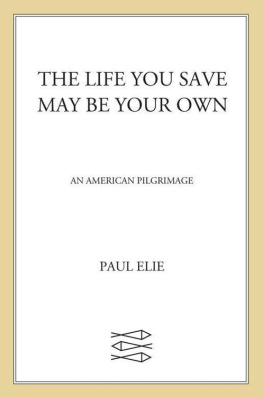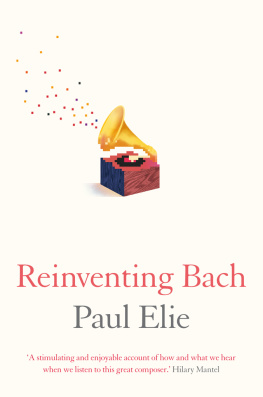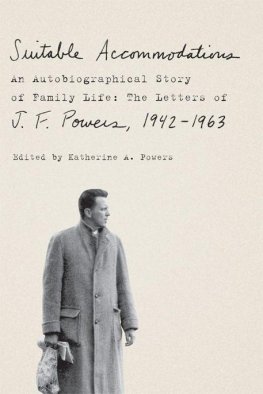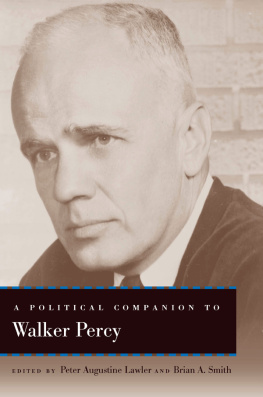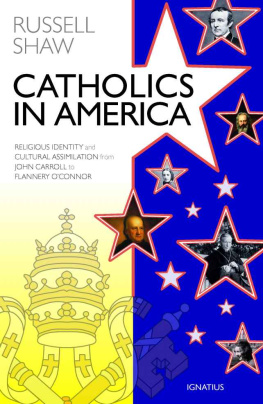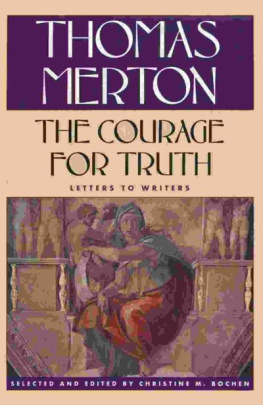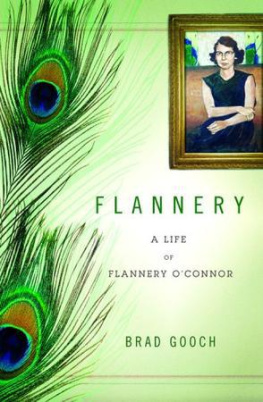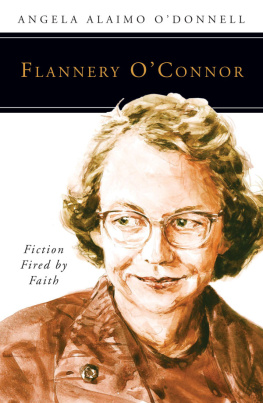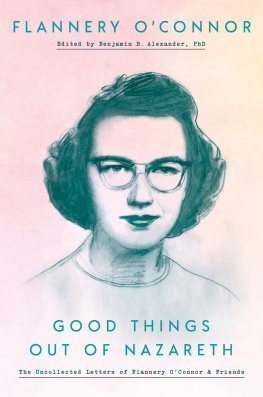On Pilgrimage
I n the photographs, they dont look like people who might make you want to change your life. Flannery OConnors black dress and big glasses suggest a pious and dutiful Georgia daughter. Thomas Merton seems to be uncomfortable in his Trappist habitall the vitality is in the eyes. Walker Percys face frames a smile, as if he is just another duffer at the country club, nattering on about the Old South. In her castoff overcoat and kerchief Dorothy Day might be a nun or a social worker, not a radical under surveillance by the FBI.
Ordinary people, on the face of itbut for many of us these photographs are icons, ideals in black and white. OConnors grim propriety is of a piece with her fiction, a pitiless enactment of the mystery and manners of the South. Mertons unease with his monastic calling kept him always striving for more perfect solitude. Percys good mood is a great achievement, an escape from the pressures of his family historyinheritance, duty, war, fatal accidents, mortal illness, depression, suicide. Days overcoat is no better than those given out to the poor men who stand on line outside the Catholic Worker, an emblem of the rough equality of every person under God.
They are writers from the middle of the last century now, who precede us the way Tolstoy and Dostoevsky, Hopkins and Henry James, preceded them. They are solidly canonical, fixed in the lens of literary posterity: anthologies, conferences, monographs, appreciation societies.
Because they prized independence, they are typically seen as great individuals, four figures who came out of nowhere and stood alone. Merton is the monk whose autobiography became a best-seller, spoiling his solitude. Day is the Greenwich Village bohemian who founded the Catholic Workernewspaper, soup kitchen, and revolutionary headquarters. Percy is the doctor who quit medicine to be a writer, stealthily slipping philosophy into his novels. OConnor is the comic genius who wrote shockingly about rural prophets and desperadoes before dying of lupus at the age of thirty-nine.
Taken together, their stories are told as episodes in a recent chapter of American religious history, in which four Catholics of rare sophistication overcame the narrowness of the Church and the suspicions of the culture to achieve a distinctly American Catholic outlook.
All of that is true and worth knowing. This book, though, will take a slightly different approach, setting out to tell their four stories as one, albeit one with four points of origin and points of view. It is, or is meant to be, the narrative of a pilgrimage, a journey in which art, life, and religious faith converge; it is a story of readers and writersof four individuals who glimpsed a way of life in their reading and evoked it in their writing, so as to make their readers yearn to go and do likewise.
What is a pilgrimage? The theme, which is found all through their work (and the work about them), is never defined precisely there; but a pattern of pilgrimage emerges, one that seems to fit Dante and Chaucer, these four writers, and the present age alike.
A pilgrimage is a journey undertaken in the light of a story. A great event has happened; the pilgrim hears the reports and goes in search of the evidence, aspiring to be an eyewitness. The pilgrim seeks not only to confirm the experience of others firsthand but to be changed by the experience.
Pilgrims often make the journey in company, but each must be changed individually; they must see for themselves, each with his or her own eyes. And as they return to ordinary life the pilgrims must tell others what they saw, recasting the story in their own terms.
In the story of these four writers, the pattern of pilgrimage is also a pattern of reading and writing. Dorothy Day could have been speaking for the group when she said the meaning of her life was to live out the imperatives found in the Gospels and in her favorite novels: all four were great readers before they were great writers. Three were Catholic converts, but it was in literature, first of all, that they found religious experience most convincingly described. As they read Dickens and Joyce, Blake and Eliot, Augustine and Kierkegaard, they recognized themselves as people with religious temperaments and quandaries.
Emboldened by books, they set out to have for themselves the experiences they had read about, measuring their lives against the books that had struck them the most powerfully. With the Catholic Worker, Day strove to embody the Gospel story literally on the streets of the Lower East Side. Merton, leaving New York and the modern world for a Trappist monastery in Kentucky, hoped to find there the life of order and purpose described in medieval philosophy. OConnor, raised a Catholic among Protestants of the Deep South, discovered herself as a writer when she recognized that the people of her part of Georgia were kin to the outsize figures in the Bible. An orphan, a survivor of tuberculosis, a descendant of illustrious melancholics, Percy saw himself as a searcher after lifes meaning, like the characters the existentialists wrote about, and he quietly slipped out of the harness of his family history to live in a small town and write fiction, testing his philosophy with his life.
Already, they saw themselves as representative figures, whose concerns were characteristically modern; and already, they were sharpening their skills as writerstrying to describe religious experience, to imagine it, to convey it to the reader as believable, exciting, profound. At first they sought to retell the stories they had read, recasting the European classics for midcentury American life. In time, as they found their own voices and means of approach, religious experience in their work would take on forms no one expected: mystical prayer in an abandoned toolshed in the woods, televised civil disobedience outside City Hall, a survivors ordeal in a cave in North Carolina, an elderly ladys epiphany at gunpoint by the roadside.
The pilgrimage of these four writers is part of a larger story of the convergence of literature and religion in the twentieth century, the effects of which are still being felt in our own time. It is a story that runs parallel to the modern history of the United States. As James Wood has pointed out, the decline of the Bibles authority in the nineteenth century coincided with the rise of the modern novel, which aspired to have something like a religious authority over the reader. In part, this development led to the defiant heterodoxy of the great modernist writers, who conceived of literature as cult, creed, and dogma, a world unto itself. And yet the Bible, in decline in Europe, retained its authority in America, and perhaps it was only natural that the religiously charged books of early modernity would prompt certain American writers to seek out actual religious experience, and then to set about writing literary work which would have a frankly religious power.
How that happened is complicated, and one way to understand it more precisely is through the notion of the anxiety of influence, which Harold Bloom applied to the English Romantic poets some years ago. If, as Bloom proposed, a writer in early maturity is beset by the anxiety of influence and must misread a great precursor in order to attain an original style, it is no surprise that some modern American writers felt the anxiety of influence with a religious intensitythat they brought books to bear on every aspect of their experience, misreading their precursors with their lives.

